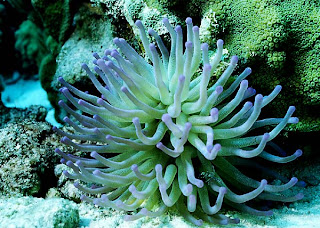The sea anemones are a large group of soft bodied animals closely related to coral-forming polyps, and belonging to the same phylum as the jellyfish. Related to corals, they reach their greatest diversity and abundance on the tropical reefs. Some of the largest sea anemones are found in Australian waters and can grow to over a metre in diameter.
Like all these creatures their bodies have a simple structure consisting of an inner and outer layer of cells. The inner layer surrounds a central cavity, with one opening to the outside world through which both food and water must pass. The outer layer consists of amass of fleshy tentacles radiating from around the mouth. Each is armed with special stinging cells uses both for defence and attack.
Sea anemones are not capable of any great movement and remain anchored to the sea bed or to rocks and corals. A special disc on the base of each animal produces a sticky cement that secures it fast, even if it is exposed to the waves in tidal rock pools.
Though they are unable to move sea anemones can draw in their tentacles by contracting muscle fibres. Those inhabiting tidal zones retract completely when they are out of the water, so they resemble blobs of jelly. Sea anemones have no brain. Instead its nerve cells simply form a network that connects its sense organs and its muscles.
Sea anemones are carnivorous and use their tentacles to catch prey. The smaller species draw the minute organisms towards their mouths by beating tiny hairs on the tentacles to create a current. Larger species prey on fish and crustaceans using their powerful stinging cells to stun or kill and mucus secretions to hold the prey fast.
A sea anemone has a muscular tube leading from its mouth into the body cavity. Once the prey has passed through gland cells secret digestive juices to break down the food. This digested product is then absorbed into the sea anemones tissue.
Sea anemones reproduce in various ways. Some can simply divide their bodies into two new individuals, others split off sections of their basal discs which then develop into a new animal and some sea anemones can also reproduce sexually.
Sea anemones provide some of natures best examples of symbiosis, the relationship in which two types of animal benefit from closely associating with one another. The cloak anemone commonly lives on the shell of the hermit crab. The crab gains protection from its predators, which are driven off by the anemones powerful stinging cells, while at the same time the anemone gains scraps of food discarded by the crab.
In tropical waters certain species of fish live happily among sea anemones tentacles. The most famous of these are the clownfish, which have a covering of protective mucus that prevents them being stung by the sea anemones tentacles. The clownfish clearly gain protection from predators and the anemones may be able to prey on those fish that chase the clownfish too far or even feed on scraps of fish food.
For related articles click onto:
All about starfish
Can starfish grow back their arms?
How many seas are there in the world?
Is the sea sponge a plant or an animal?
Keystone species
Sea animals: Sea Anemones
Sea cucumber facts
Seahorse facts
Star Starfish
The seahorse
The sea cucumber
What is a sea sponge?
What is a cuttlefish?
What is a sea anemone?
What is a starfish?
Why is the Dead Sea so salty?
What is the difference between the sea and the ocean?
What is the Gulf Stream?





No comments:
Post a Comment